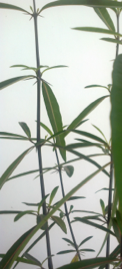Bisa Ular
| Bisa Ular | |
| Scientific Name | Barleria lupulina Lindl |
| Family | Acanthaceae |
 |
{slider=Geographical & Distribution}
South East Asia
{/slider}
{slider=General Appearance}
Small shrub. The plant can reach the height of 1.5 m. Stem glabrous with branching. Two or three pairs of spines 5-20mm long in the leaf axils. The leaves are linear oblong, 3-9.5 cm x 0.9x1.4 cm. Petiole up to 0.6cm long. Red midrib. Inflorescence in the form of spikes that are erect, terminal, yellow in color.
{/slider}
{slider=Chemical contents}
From the aerial part of Barleria lupulina, 8-O-acetyl-6-O-trans-p-coumaroylshanzhiside, saletpangponosides A–C and 8-O-acetylmussaenoside were isolated together with 13 known compounds (Kanchanapoom T et al 2000), Iridoid glucosides. The leaf and stem contain alkaloid.
{/slider}
{slider=Traditional Uses}
To treat poisonous bites: Crush the leaves and apply on the affected area.
Externally used as an antiinflammatory for insect bite, herpes simplex and herpes zoster.
Treatment of rheumatoid arthritis.
The rural people of Tamilnadu use the fresh juice of the crushed plant to relieve mental tension and disturbance. The aerial parts of the plant are used by the rural people of West Bengal for the treatment of diabetes, snake bites and rheumatoid arthritis (Chopra et al., 1968).
From the leaves of medicinal plant B. lupulina a betaine compound was isolated (Tuntiwachwuttikul et al., 1998).
{/slider}
{slider=Pharmacology}
Anti-diabetic activity
The methanol extract of aerial parts of Barleria lupulina exert significant anti-hyperglycemic efficacy at all levels tested from 4 h after its administration, as compared with the control group, and effect was prolonged up to 12 h. The extract at doses of 200 mgkg-1 body wt., and above exhibited a maximum activity (p< 0.001) at 12 h after administration. The most significant activity (15.35 % blood glucose reduction) was observed for the group administered 300 mgkg-1 body wt. At 12 h after administration, while the standard drug glibenclamide (10mg/kg-1 body wt.) showed an 18.80 % reduction of blood glucose at the same time interval(Suba V. et al., 2002).
Central NervousSystem (CNS) activity
The methanol extract (100, 200 and 300 mg/kg) showed reduction in general behavioral pattern (spontaneous activity, alertness, awareness, pain response and touch response) in a dose dependent manner. The extract was found to produce a significant reduction of the exploratory behavioral profile (Y-maze test, head dip test) and conditioned avoidance response with all the tested doses. The methanolic extract showed significant motor incoordination and muscle relaxant activity. The extract also potentiated phenobarbitone sodium induced sleeping time. Preliminary investigation showed that the methanol extract of B. lupulina has significant psychopharmacological activity (Suba et al 2002).
Virucidal effects
Virucidal effects of organic extracts of these two plants against herpes simplex virus type 2 strain G, HSV-2 (G), the standard HSV-2 strain. The extracts were assessed for intracelular activities against HSV-2 and five clinical HSV-2 isolates. B. lupulina extract exhibited activity against all five isolates but not the standard stain.
Anti-arthritic & Immunomodulatory Activity
Methanol Extract of B.lupulina leaves 300 mg/kg and 600 mg/kg showed statistically significant inhibition (P<0.05 and P<0.001) of the edema formation and Myeloperoxidase (MPO) during experimental period and activities of antioxidants were restored significantly. MEBL extracts 300 mg/kg and 600 mg/kg significantly increased the Hemoglobin (Hb) level, serum albumin, total protein, calcium and phosphorus levels and reverted back the levels of WBC count and Erythrocyte Sedimentation Rate (ESR) (P<0.05 and P<0.01). Histopathological studies of ankle joints also supported this finding. Immunomodulatory study revealed an increase in the blood leukocytes count, weight of spleen, spleenic leukocytes count and increase in paw volume on delayed type hypersensitivity footpad thickness suggesting an uplift of immune status (Mazumder P.M. et al 2012).
{/slider}
{slider=Reference}
Suba V., T. Murugesan, G. Arunachalam, S.C. Mandal, B.P. Saha Anti-diabetic potential of Barleria lupulina extract in rats. Phytomedicine Vol 11 (2) Pg 202-205
References: Tripetch Kanchanapooma,b, Ryoji Kasaia, Kazuo Yamasakia ( 2001) Iridoid glucosides from Barleria lupulina. Phytochemistry 58 (2001) 337–341
Papiya Mitra Mazumder, Anindita Mondal, Dinakar Sasmal, Sinnathambi Arulmozhi, Paramaguru Rathinavelusamy (2012). Evaluation of antiarthritic and immunomodulatory activity of Barleria
Lupulina Asian Pacific Journal of Tropical Biomedicine S1400-S1406.
R.N. Chopra, S.L. Nayar, I.C. Chopra Glossary of Indian Medicinal Plants, Academic Publishers, New Delhi, India (1968), p. 20
Suba V. T.m Murugesan, R.B. Rao, M. Pal, S.C. Mandal, B.P. Saha (2002). Neuropharmacological profile of Barleria lupulina Lindl. Extract in animal models. Journal of Ethnopharmacology (81) (2) Pg 251-256.
http://www.globinmed.com/index.php?option=com_content&view=article&id=79313:barleria
{/slider}
- Last updated on .
- Hits: 1104
